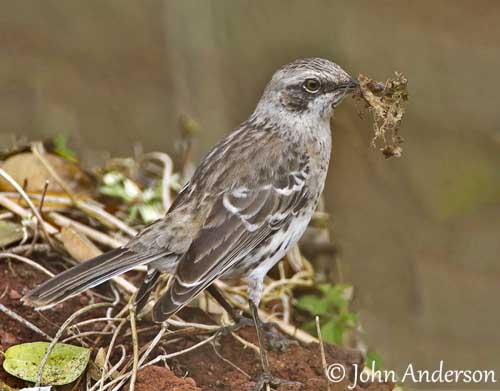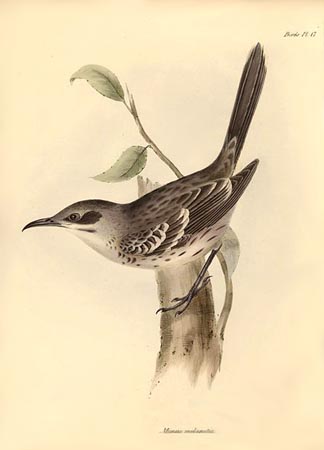
Fr: Moqueur de San Cristobal
All: San Cristobal-Spottdrossel
Esp: Sinsonte de San Cristóbal
Ita: Mimo di San Cristobal
Nd: San-Cristobalspotlijster
Sd: San Cristobalhärmtrast
Photographer:
John Anderson
John Anderson Photo Galleries
Illustration:
John Gould: 1804-1881
Text by Nicole Bouglouan
Sources:
HANDBOOK OF THE BIRDS OF THE WORLD Vol 10 by Josep del Hoyo-Andrew Elliott-David Christie - Lynx Edicions - ISBN: 8487334725
WRENS, DIPPERS AND THRASHERS by Brewer David – illustrated by Barry Kent Mackay- Yale University Press - ISBN: 0300090595
BirdLife International (BirdLife International)
San Cristobal Mockingbird
Mimus melanotis
Passeriformes Order – Mimidae Family
INTRODUCTION:
The San Cristobal Mockingbird or Chatham Mockingbird is the smallest of the Galapagos Mimidae. This is the only mockingbird on San Cristobal Island. This one is fairly shy compared to the Hood Mockingbird. This species is not known for breeding co-operatively, in spite of an additional adult.
DESCRIPTION OF THE BIRD:
Biometrics:
Length: 25-26 cm
Weight: M: 53 g – F: 48 g
The adult has greyish-brown crown and upperparts. Two white wingbars are visible on the upperwing, formed by the white tips of the wing-coverts. The flight feathers and the tail are dark brown, but the outer rectrices are tipped white.
The underparts are whitish, with pale buff wash on throat. There are several small dark spots on breast sides. Flanks are streaked blackish-brown.
On the head, there is a narrow whitish supercilium. Lores and ear patches are blackish, like the narrow malar stripe.
The decurved bill is shorter than in other Galapagos species. It is blackish, like legs and feet. The eyes are reddish-brown to amber.
Both sexes are similar, but the female is smaller than male.
The juvenile has more streaked underparts than adults.

RANGE:
The San Cristobal Mockingbird is confined to San Cristobal (Chatham) Island, in E Galapagos Islands.
HABITAT:
The San Cristobal Mockingbird frequents a wide range of habitats from mangroves and arid lowland scrub, to forest patches with tall trees such as Bursera and Piscidia, and stands of cacti of genus Opuntia.
It usually avoids the dense lowland forest and the wetter woodland, the grassland and the areas built by humans.
CALLS AND SONGS: SOUNDS BY XENO-CANTO
The San Cristobal Mockingbird utters loud but melodious advertising song, typical of this genus.
BEHAVIOUR IN THE WILD:
The San Cristobal Mockingbird feeds on terrestrial arthropods such as Orthoptera (grasshoppers and crickets), but it also takes fruits and berries. It forages on the ground, by scratching over the leaf litter to find preys.
It is not known for attacking seabirds for their eggs, probably due to its relatively small bill. In the same way, blood-drinking for living iguanas has not been observed, although it occasionally picks ticks from their skin.
The San Cristobal Mockingbird defends its territory by a “posture-dance”. It can become aggressive in the vicinity of the nest and performs “wing-flashing”.
The territory is much larger than in other Galapagos Mimidae, about 3-5 ha or more. It is occupied by one pair and an additional adult, usually a subordinate male.
The San Cristobal Mockingbird is sedentary and only performs short flights within its range.

REPRODUCTION OF THIS SPECIES:
The breeding season occurs between January and April, later at higher elevation.
Both adults build a bulky nest with a foundation of dry twigs, but the most part of the structure is made with moss, dry weeds and grass stems. The inner part is lined with softer grasses. The nest is placed about 4-5 metres above the ground in a crotch of tree, to avoid predators.
The female lays 2-5 greenish eggs with darker markings. She incubates alone, but the chicks are fed by both parents.
Incubation and fledging periods are unknown.
PROTECTION / THREATS / STATUS:
The San Cristobal Mockingbird has very restricted range on a single island. The species is vulnerable to human activities.
Its habitat has suffered degradation and destruction due to invasive plants and animals, and to the increase of human population.
The nests are attacked by introduced cats and rats. Avian parasites and diseases from chicken farms are growing threats too.
Currently, the San Cristobal Mockingbird is classified as Endangered.